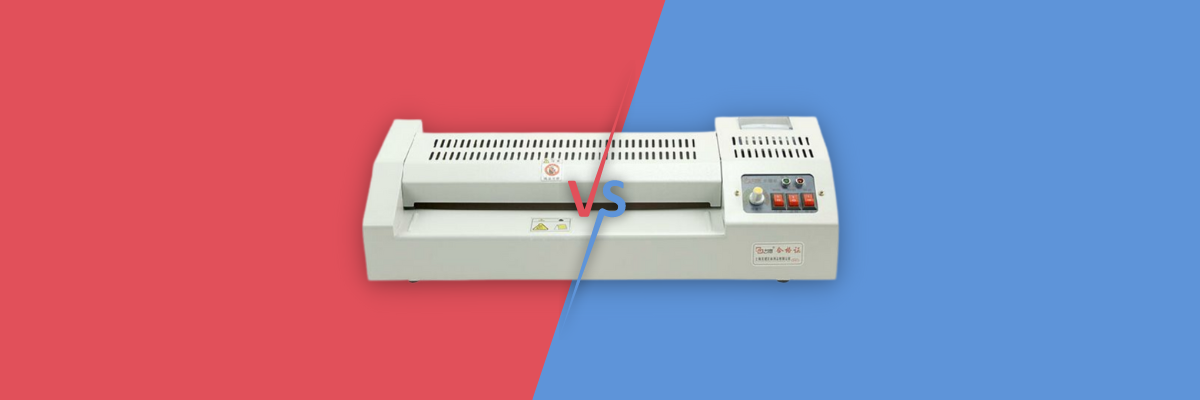Despite the significant development and innovation in office technology, laminators are still considered essential tools for preserving important documents in schools, offices, homes, and print shops. Laminators are versatile machines with varying sizes and functionalities, each catering to ever-changing consumer needs. Choosing the right kind of laminator can be a daunting task, especially for first-time buyers. A common problem when selecting a laminator is the uncertainty surrounding whether to opt for a hot or cold laminator. The primary difference between hot vs. cold lamination depends on how the plastic is applied to the document by the laminating machine.
Both laminating machines offer advantages and disadvantages; the choice ultimately depends on user needs and preferences. This article will help you explore the benefits and drawbacks of each type of laminator and make an informed decision per your needs.
Hot Laminators
Hot laminators are exceptional machines for laminating pressure-sensitive materials with a crystal-clear finish. These laminators use heat to activate and melt the adhesive of the lamination film to bond with the material. As a result, it creates a strong seal to protect documents from moisture, dirt, creases, and other potential damages. A few points to consider while buying a hot laminator are:
- Hot laminators can laminate any flat item, including photographs, glossy paper, and artwork.
- Besides traditional materials, these machines laminate versatile materials, including vinyl, and offer various heat settings.
- Hot laminators are known to provide more durable protection with relatively faster operations.
- The materials used in a hot laminator are cost-friendly, with an exceptional price-to-performance ratio.
- A hot laminator might require a little practice while dealing with heated rollers, but the resulting coating is wear resistant.
- Hot laminating technology can work with various laminating films, thus delivering a matte, glossy, and silk matte finish.
Dry Lam Hot Laminators belong to their revolutionary Elements Series with adjustable heat settings to ensure temperature control according to your requirements. With rapid warm-up time, speed, and built-in safety features, Dry Lam provides a hassle-free lamination experience.
Explore Dry Lam CL-27DX Deluxe Laminator, CL-40PR Professional Laminator, and CL-40SD Standard Laminator with value-packed features. Moreover, these hot laminators can be upgraded with compatible upgrade kits to provide an exclusive all-in-one package.
To keep these laminating machines running smoothly, pair them with Dry Lam laminating films to achieve a matte, glossy, or silk matte finish.
Cold Laminators
Cold laminators are innovative machines that protect heat-sensitive materials prone to heat damage. They use pressure to bond two layers of material together to create a crease-free protective coating. The machine consists of two rollers, one on top and one on the bottom. The material to be laminated is placed between two rollers, and pressure is applied to the rollers. A few points to consider while buying a cold laminator are:
- Cold laminators are user-friendly machines with minimal setup time and require less maintenance.
- Cold lamination is best suited for small-scale projects that require a lower level of durability, such as photographs, ID cards, and business cards.
- The pressure from the rollers in a cold laminator removes potential bubbles within the coating resulting in a smooth protective layer.
- Cold lamination technology ensures better colors and a fine print of the document within the lamination film.
- Cold laminating technology produces a matte finish less prone to glare and reflection, making it ideal for materials viewed under bright lights or outdoors.
Dry Lam Cold Laminators are tailored to provide a seamless user experience without the risk of heat damage to your crucial documents. Look no further and shop our LPP6512 - 25” Wide Format Roll Laminator, a versatile option for small offices, schools, and homes. Pair it with our wear-resistant laminating films for a durable and long-lasting finish.
Conclusion
Choosing between hot and cold lamination ultimately depends on the nature of your project and personal preferences. It's essential to consider the materials you are laminating, the desired finish, and your budget when deciding between hot vs. cold lamination. Each option has its benefits and drawbacks, so weighing them against your specific project needs is crucial.
Not sure which machine is right for you? Contact us for expert advice, a personalized recommendation or to schedule a live demo. Call us at (800) 992-5279

